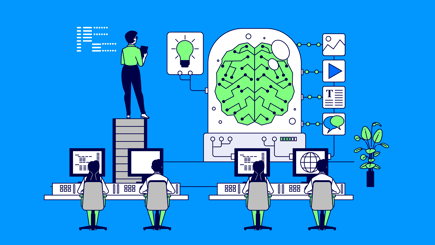%20(1).webp)
How to carry out a digital onboarding process successfully
-
According to Platzi, onboarding refers to the process of integrating someone into an environment, that is, if we talk about e-commerce, it’s the way to simplify an experience and make it easier to understand. This concept is very useful because it allows you to guide your digital projects with agility and also achieve other objectives such as:
- Clearly demonstrate objectives
- Understand the terminology and technical aspects of the project.
- Forming and stabilizing more stable work teams
- Directing and re-directing actions towards the main objective.
Let's see an example: You enter a house and you see a beautiful front garden, the flowers adorn the terrace in a special way, the flower pots hang with sophisticated detail, and the fresh scent of nature is overwhelming. Do you imagine it like this?
Or do you imagine something like this?
The decoration is not designed by accident and nothing is distributed by chance, each element has an objective and a function that is defined during an onboarding process. When we articulate all these elements in our front garden we do so with one objective: to make a good first impression on our friends or family who come to dinner, making them feel comfortable from the moment they enter our garden.
And in our eCommerce: How do we welcome users?
This is not a minor thing, let's continue with a relevant premise: "First impressions matter". The user experience is key regarding this point, we have to progressively manage all the information that we will ask the user at the time of purchase, create a profile in a form, start the onboarding in an application or design the first interactions with the products.
The above allows us to confirm that first impressions in the context of digital products are very important. The superior argument is that we can condition the experience within our application with a light, interactive onboarding process, which adds value to the user's expectations or, on the other hand, a bad experience can generate friction and the user will lose interest in our products or generate a rebound effect in the online channel.
Examples of onboardings that have caused attraction
-
Duolingo
A classic example! Duolingo, the application to learn languages in an interactive way, starts entertaining the user from the first interaction, this principle is key and is related to gamification. First, at the moment of requesting your personal information, the application does it in an interactive way and under a key argument: "entertaining learning of languages", this is intrinsically related to its value proposition.
-
Headspace
This mobile meditation app was adapted so that the user can perform a guided onboarding sequence to select the duration of a meditation session. Therefore, this onboarding starts to teach the user its value proposition during the first few clicks before reaching the "key moment".
It also has some progressive information. The data request is done in logically structured sequential steps. This is not only strategic, but is also related to not saturating the user cognitively to complete their data, so that the user's attention is focused on their ultimate goal which is to schedule a meditation session, and that is where Onboarding collaborates fluently to fulfill this purpose.
-
Tik tok
If you like making viral videos in this app, it’s likely that when you started using it you realized 2 things: you learned how to share videos from the beginning of the app and you realized that it’s more intuitive to consume content than to create it. This is evidence of a strategic business decision, and it’s because Tik Tok recognizes that most of its new users come to watch before creating.
It’s also important to mention that in its first interactions during the onboarding process, Tik Tok teaches the new user the most relevant actions, increasing and improving the online app adaptation process.
.
-
Wealthfront
Surely, sensitive information such as bank details would be safely guarded, right? And following that logic, if you were asked to add a bank account to explore different financial routes within an onboarding flow, you would think 1001 times before agreeing to. That is, unless you are using Wealthfront, its Onboarding process allows you to highlight simplified integration and add value from the first click.
Within the first interactions, the new user must add their account with the objective of creating their financial plan for free. This makes the user feel the pulse of the application’s value proposition from the very start of the Onboarding process, shortening the gap between the first click and the key moment of the experience.
How is this trust exchange achieved? With engaging interactions that focus on controlling the user's impulses, from adding their data to signing up for an investment account.
Based on the above, it’s important to identify some key points that will contribute to an effective onboarding implementation and definition... Take notes and keep these in mind!
Progressive information
Let's say your first job as a UX designer is designing an onboarding process that includes a user profile creation. Let's get to work! But wait, not so fast! Continuing with the example, before bringing your guests into the dining room: aren't you going to offer them an appetizer in the garden, aren't you proud of your garden decoration? In other words, a brief welcome to the app doesn’t hurt.
The information must always be structured in sequential steps, we want the user to be entertained, not abandon the product due to an excessive cognitive load.
Point the user to the “key moment” from the start
The "key moment" or "the moment of truth" is that moment where the user interacts directly with the value proposition of the app, it’s the peak moment of a product where the user's needs are solved with the value of the service or, following to our example, it’s when you invite your guest to go directly to the dining room. This means that you don't want the conversation in the front yard to be too long.
Effective Onboarding is brief but keeps the user motivated until the "key moment", we must consider that people operate under unconscious processes, that is, if you can make your user commit to a brief action such as creating an account in a few steps, it’s very likely that they will later commit to a more significant action, such as buying or hiring a service in your e-commerce.
Successful onboarding does exist
Finally, I want to share some principles with you, for your new guest to have an entertaining and easy onboarding flow. The table is set, the dinner is hot and the guests are about to have a pleasant evening, to make this moment memorable, keep the following principles in mind:
- Successful navigation keeps the user flowing intuitively through the rest of the application.
- Keep users motivated until they reach the key moment.
- Deliver value from the first user interactions.
- Good onboarding connects the user to the value proposition
If you still have doubts about how to establish the correct onboarding process, we recommend you follow this action plan:
- Defining your product’s value proposition.
- Designing the information architecture.
- Interaction design.
- Prototyping








